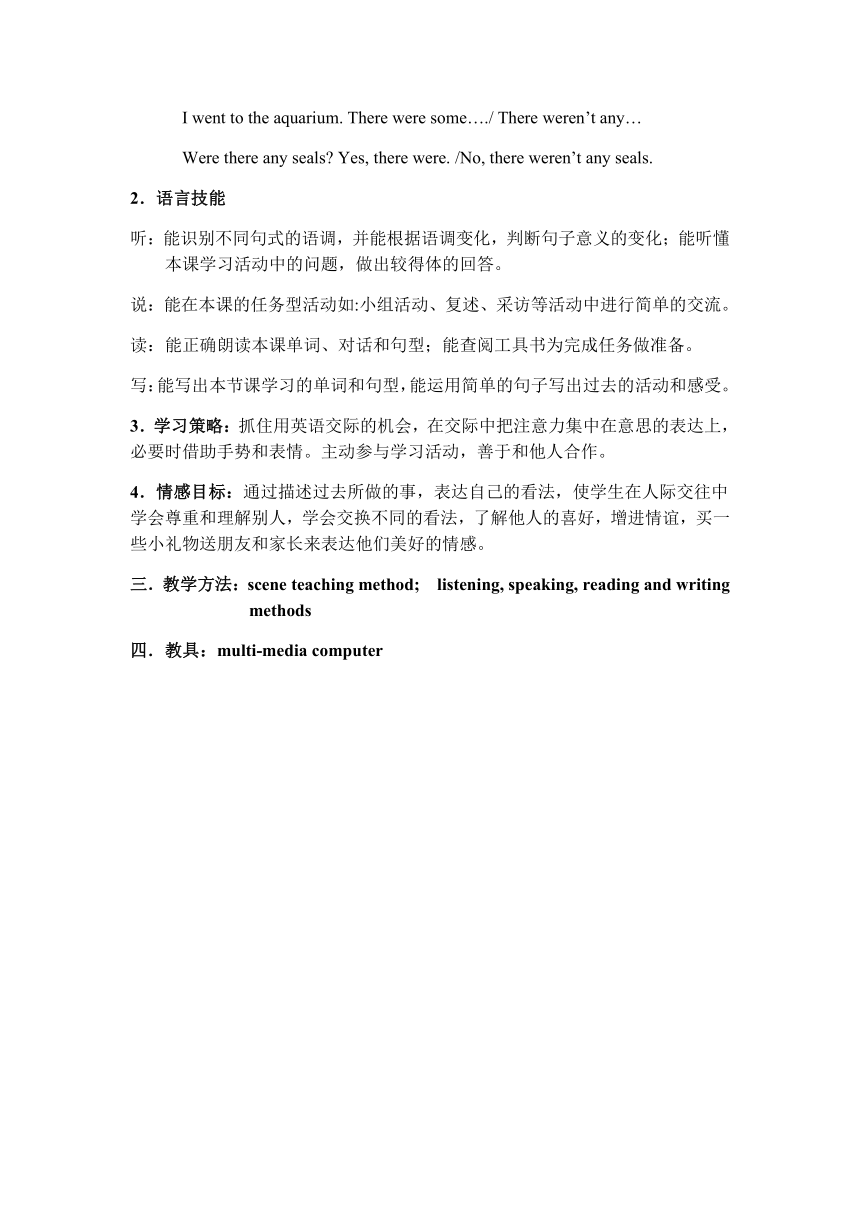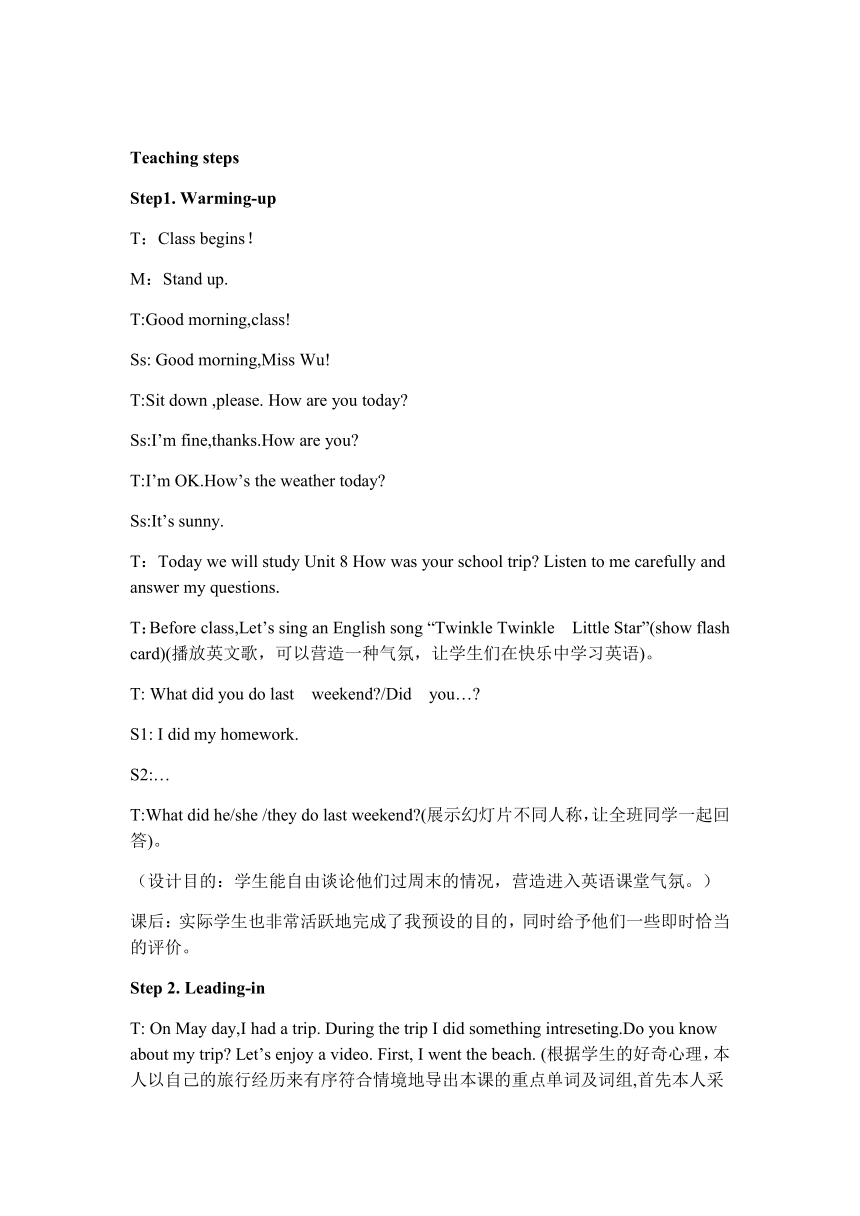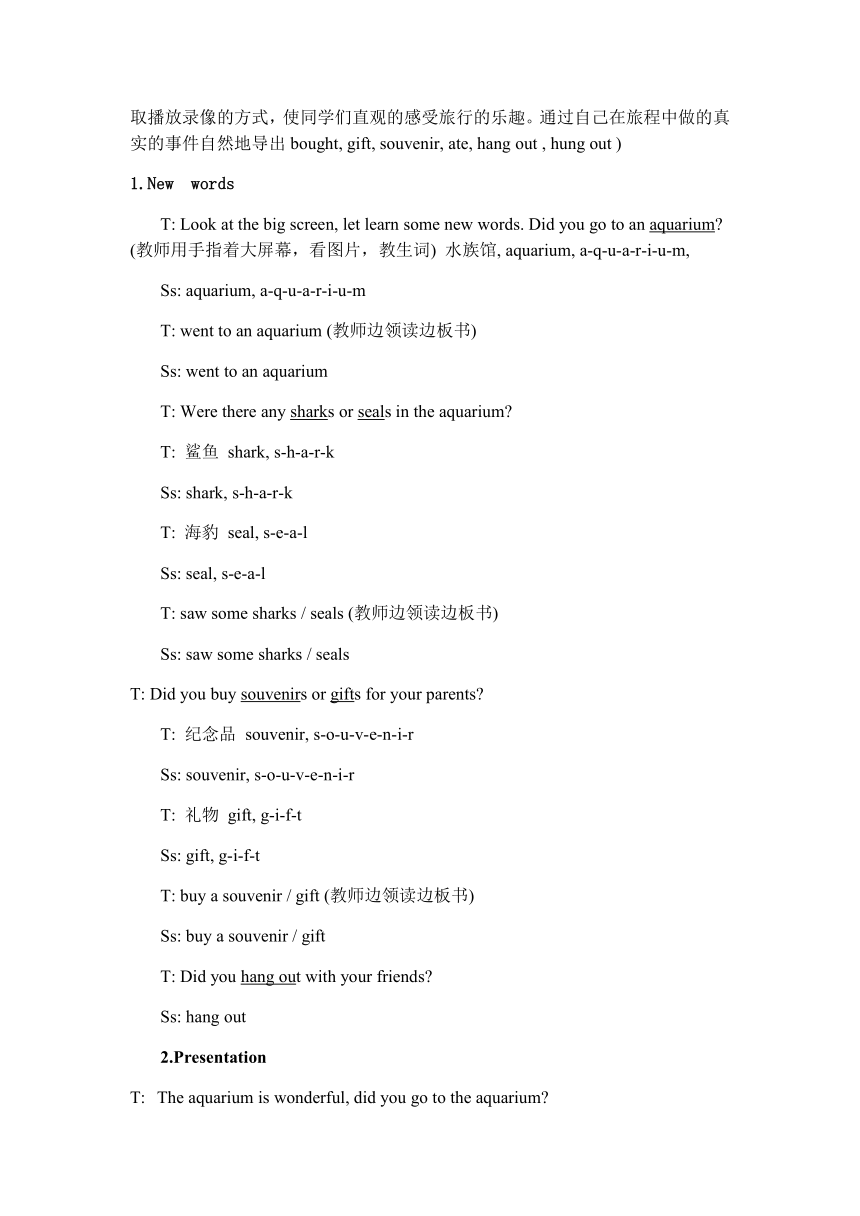2020年春Unit 11 How was your school trip? Section A 1a-1c 教学设计
文档属性
| 名称 | 2020年春Unit 11 How was your school trip? Section A 1a-1c 教学设计 |  | |
| 格式 | zip | ||
| 文件大小 | 45.5KB | ||
| 资源类型 | 教案 | ||
| 版本资源 | 人教新目标(Go for it)版 | ||
| 科目 | 英语 | ||
| 更新时间 | 2020-05-18 20:47:22 | ||
图片预览





文档简介
2020年春人教新目标英语七年级下册
Unit11 How was your school trip?
Section A 1a-1c
一、教学重点及难点
1.重点
1.学习词汇 aquarium, seal, shark, , hang, hang out, souvenir,
本课时拓展词汇:sea horse, octopus starfish
2.不规则动词过式:had, was, went, saw, were, took, bought, ate, hung, met
3.学习句型 Did you go to the aquarium? Yes, I did. No, I didn’t.
Were there any seals? Yes, there were. No, there weren’t.
I went to…/ bought…/ met…./ had….
There were some…./ There weren’t any…
2.难点
1)一般过去时的不规则动词。
2)Were there any…? 引导的一般疑问句。
二.教学目标
1.知识目标
单词:学习掌握词汇aquarium, seal, shark, octopus等。
功能:描述过去发生的事情
语言结构:⑴ 不规则动词的过去式
⑵ 一般过去时的一般疑问句
句型:Did you go to the zoo? Yes, I did. No, I didn’t.
I went to the aquarium. There were some…./ There weren’t any…
Were there any seals? Yes, there were. /No, there weren’t any seals.
2.语言技能
听:能识别不同句式的语调,并能根据语调变化,判断句子意义的变化;能听懂本课学习活动中的问题,做出较得体的回答。
说:能在本课的任务型活动如:小组活动、复述、采访等活动中进行简单的交流。
读:能正确朗读本课单词、对话和句型;能查阅工具书为完成任务做准备。
写:能写出本节课学习的单词和句型,能运用简单的句子写出过去的活动和感受。
3.学习策略:抓住用英语交际的机会,在交际中把注意力集中在意思的表达上,必要时借助手势和表情。主动参与学习活动,善于和他人合作。
4.情感目标:通过描述过去所做的事,表达自己的看法,使学生在人际交往中学会尊重和理解别人,学会交换不同的看法,了解他人的喜好,增进情谊,买一些小礼物送朋友和家长来表达他们美好的情感。
三.教学方法:scene teaching method; listening, speaking, reading and writing methods
四.教具:multi-media computer
Teaching steps
Step1. Warming-up
T:Class begins!
M:Stand up.
T:Good morning,class!
Ss: Good morning,Miss Wu!
T:Sit down ,please. How are you today?
Ss:I’m fine,thanks.How are you?
T:I’m OK.How’s the weather today?
Ss:It’s sunny.
T:Today we will study Unit 8 How was your school trip? Listen to me carefully and answer my questions.
T:Before class,Let’s sing an English song “Twinkle Twinkle Little Star”(show flash card)(播放英文歌,可以营造一种气氛,让学生们在快乐中学习英语)。
T: What did you do last weekend?/Did you…?
S1: I did my homework.
S2:…
T:What did he/she /they do last weekend?(展示幻灯片不同人称,让全班同学一起回答)。
(设计目的:学生能自由谈论他们过周末的情况,营造进入英语课堂气氛。)
课后:实际学生也非常活跃地完成了我预设的目的,同时给予他们一些即时恰当的评价。
Step 2. Leading-in
T: On May day,I had a trip. During the trip I did something intreseting.Do you know about my trip? Let’s enjoy a video. First, I went the beach. (根据学生的好奇心理,本人以自己的旅行经历来有序符合情境地导出本课的重点单词及词组,首先本人采取播放录像的方式,使同学们直观的感受旅行的乐趣。通过自己在旅程中做的真实的事件自然地导出bought, gift, souvenir, ate, hang out , hung out )
1.New words
T: Look at the big screen, let learn some new words. Did you go to an aquarium? (教师用手指着大屏幕,看图片,教生词) 水族馆, aquarium, a-q-u-a-r-i-u-m, ?
Ss: aquarium, a-q-u-a-r-i-u-m
T: went to an aquarium (教师边领读边板书)
Ss: went to an aquarium
T: Were there any sharks or seals in the aquarium?
T: 鲨鱼 shark, s-h-a-r-k
Ss: shark, s-h-a-r-k?
T: 海豹 seal, s-e-a-l?
Ss: seal, s-e-a-l?
T: saw some sharks / seals (教师边领读边板书)?
Ss: saw some sharks / seals?
T: Did you buy souvenirs or gifts for your parents?
T: 纪念品 souvenir, s-o-u-v-e-n-i-r
Ss: souvenir, s-o-u-v-e-n-i-r
T: 礼物 gift, g-i-f-t
Ss: gift, g-i-f-t
T: buy a souvenir / gift (教师边领读边板书)
Ss: buy a souvenir / gift
T: Did you hang out with your friends?
Ss: hang out?
2.Presentation
T: The aquarium is wonderful, did you go to the aquarium?
Ss:Yes, I did./No I didn’t.(很自然的导入到过去时的一般疑问句)
T:Were there any sharks in the aquarium?
Ss:Yes ,there were. There were some sharks in the aquarium.
3 Do you remember?
T: Do you remember what I saw in the aquarium?(这一步设计的意图旨在让学生加深对新词的记忆并导出were there…?句型, 让学生学会它的简单回答。Yes, there were. /No, there weren’t .)
T: Good. Were there any….s? Yes, there were./ No, there weren’t.
Were there any…s in the aquarium?
Yes ,there were. No, there weren’t.
Step 4 Try to practice
T: Of course , there were many animals in the aquarium, what other animals there were in the aquarium? Do you want to know?
Please ask and answer like this:
Were there any…s?
And I will tell you . (Repeat with about 10 students.)
Were there any …s in the aquarium?
(本环节设计的目的:让学生试着用句型:Were there….?来问题。让学生能熟悉这个在上个步骤出现从本人口中说出的Were there…?的句型。)
Step 5. Listen 1b
T: Now, we are going to listen to a conversation about Tina's school trip and answer this question: What did Tina do on her school trip? Listen and circle the expressions in the box. (Play the recording the first time. Students only listen. Then play the recording a second time. Check the answers: What expressions did you circle in the box??)
T: S, please.?
S: went to the aquarium, saw some seals, hung out with her friends, took photos?
T: Good job! OK. Have you got the correct answers? Let's listen to the tape again. Please repeat. 让我们一起跟录音机再把对话读一遍。(逐句播放,学生逐句重复) (Ask students to look at the picture in activity 1a. Then point out the sample conversation in activity 1c. Ask two students to read it to the class.) S23 and S24, please.
S23: Did Tina buy a souvenir?
S24: No, she didn't. Her friend Grace bought a souvenir.?
Step 6 Groupwok Talk show: Interview Time(采访采访活动)
T: Now I’d like to know your trips. Please interview your classmates. And act out .
reporter can ask like:
Hints(提示):
1. Where did you go?
2. What did you do there?
3. How did you go there ?
4. Who did you go with?
5. How was your trip?
T:You did very well.Do you like animals?But some people killed the animals in our country .We must stop them from killing the animals. So we must try to protect animals.OK? (第一课时应该是以听说为主的课时,所以最后的采访活动是测试和检验学生是否能顺利且富有创造性语言综合实践的最关键步骤。根据学生课堂表现,学生表现出色,也受到在座的听课老师的好评。在每组学生采访表演之后,同时问一些相关的问题,这样可以培养其他在观看表演的学生学会倾听、记忆和思考的好习惯。最后本人的总结是对学生进行适时的德育教育渗透,教育学生们要保护动物。)
Step 7 Summary
T: Well , look ,today what did we learn? (Let ss talk about what they learned.)
Key words:
Shark, seal, sea horse, souvenir, gift, hang out, aquarium….
Key patterns:
Did you ….? Yes, …did. / No, … didn’t.
There were some….There weren’t any….
Were there any …s? Yes, there were. / No, there weren’t.
Key verbs of past form:
go-went, do-did, are-were, have- had, eat-ate, buy- bought, take-took, see – saw, hang – hung
(本课教学的任务旨在有效性的充分体现,所以最后这一步似乎被很多英语老师遗忘的一步,实际要本人认为是传统课堂教学中精华之一,这一步总结不仅帮学生梳理了本课时的重点学习内容,也帮助学生建构知识系统和学习方法起到了很好的辅助作用。)
Homework:
1. Copy and read the key words and expressions.抄写新词和词组.
2. Make up a conversation about one of your trip , then write down and practice with your partners.编写一个对话,并写下来,再与同伴操练.
3. Write a short passage about your trip .写一篇关于自己旅行的经历的小短文.
4. Be ready for 2a-3a.(预习2a—3a)
(作业层次性设计是为了更好地尊重各层次学生的实际需要,更是对课堂教学有效性在课外的延伸)
Blackboard Design
Unit 8 How was your school trip? Section A 1a-1c
Did you go to the aquarium? Yes, I did ./ No, I didn’t. ….I went to… bought some …. hung out with…
There were some sharks. weren’t any seals Were there any sea horses in an aquarium . starfish ? octopuses
Yes ,there were. / No, there weren’t.
教后反思:
本课时整体设计思路清晰且具有很强的梯度性,环环相扣,每个语境真实有效。课堂活动形式多样,易于操作,贴近学生生活,目的性明确。板书简洁,重点突出。本节课还有几处比较成功的尝试,为课堂有效性的教研活动提供了一些好的借鉴:一,是对不规则动词过去式在PPT中的板书形式细节创新做法;二是,1b听力材料的两步深入处理;三是采访活动结束后,适时地、恰如其氛地进行了德育教育,使课堂进入教学中教育思想升华;四是总结部分,让学生自然地进行本课时新知识的系统梳理,为学生的知识系统构建起到了一定的辅助作用,也为课堂教学的有效性提供服务功能;五是板书设计的简洁、美观。
学生上课材料:
Unit 8 How was your school trip? Section A 1a-1c
1.Listen and circle. What did Tina do on her school trip?
2.Listen and fill the blanks.
1) listen and fill in the blanks.(听对话,补全对话)
Kevin: Hi, Tina. How was your trip?
Tina: It _____fantastic, really fantastic.
Kevin:____you go to the zoo?
Tina: No, I didn’t. I_____ to the aquarium. Look, here are my photos.
Kevin: Were there any sharks?
Tina: No, there weren’t any sharks, but there ____ some really clever seals .
Kevin: Wow, that sounds wonderful ! What did you do?
Tina: Well, I _ out with my mother and I _ _ lots of photos.
2) According to the conversation , fill in the blanks.(根据上面的对话,选择正确的单词补全小短文)
2) Tina _____ a fantastic school trip last weekend. First she ____ to the aquarium. And she _____ some clever seals. Then she _____ out with her friends. Finally, she _____ lots of photos there. She _____ very happy.
Retell the story.
Last month, Liu Xiang had a trip too. First , he went to…. Then he….Next,…. After that, he…..Finally,…
Sharing time
Writing:
Talk and acting Show : Interview TimeInterview two or three of your classmates’ trips. Work in groups. (三、四人一组:一人为记者,采访其两三位同学。)
Hints(提示):1. Where did you go? 2. What did you do there? 3. How did you go there ? 4. Who did you go with? 5. How was your trip?
Interview like this:A: Hello, I am …from school magazine / Pinyang TV / Wenzhou Evening Paper… May I ask some questions about your trips? Where did you…?...B:…A: How about you?C:I went …A: And you?D: … A: That’s all , thanks. B、C and D: You’re welcome
was took had saw hung went
Unit11 How was your school trip?
Section A 1a-1c
一、教学重点及难点
1.重点
1.学习词汇 aquarium, seal, shark, , hang, hang out, souvenir,
本课时拓展词汇:sea horse, octopus starfish
2.不规则动词过式:had, was, went, saw, were, took, bought, ate, hung, met
3.学习句型 Did you go to the aquarium? Yes, I did. No, I didn’t.
Were there any seals? Yes, there were. No, there weren’t.
I went to…/ bought…/ met…./ had….
There were some…./ There weren’t any…
2.难点
1)一般过去时的不规则动词。
2)Were there any…? 引导的一般疑问句。
二.教学目标
1.知识目标
单词:学习掌握词汇aquarium, seal, shark, octopus等。
功能:描述过去发生的事情
语言结构:⑴ 不规则动词的过去式
⑵ 一般过去时的一般疑问句
句型:Did you go to the zoo? Yes, I did. No, I didn’t.
I went to the aquarium. There were some…./ There weren’t any…
Were there any seals? Yes, there were. /No, there weren’t any seals.
2.语言技能
听:能识别不同句式的语调,并能根据语调变化,判断句子意义的变化;能听懂本课学习活动中的问题,做出较得体的回答。
说:能在本课的任务型活动如:小组活动、复述、采访等活动中进行简单的交流。
读:能正确朗读本课单词、对话和句型;能查阅工具书为完成任务做准备。
写:能写出本节课学习的单词和句型,能运用简单的句子写出过去的活动和感受。
3.学习策略:抓住用英语交际的机会,在交际中把注意力集中在意思的表达上,必要时借助手势和表情。主动参与学习活动,善于和他人合作。
4.情感目标:通过描述过去所做的事,表达自己的看法,使学生在人际交往中学会尊重和理解别人,学会交换不同的看法,了解他人的喜好,增进情谊,买一些小礼物送朋友和家长来表达他们美好的情感。
三.教学方法:scene teaching method; listening, speaking, reading and writing methods
四.教具:multi-media computer
Teaching steps
Step1. Warming-up
T:Class begins!
M:Stand up.
T:Good morning,class!
Ss: Good morning,Miss Wu!
T:Sit down ,please. How are you today?
Ss:I’m fine,thanks.How are you?
T:I’m OK.How’s the weather today?
Ss:It’s sunny.
T:Today we will study Unit 8 How was your school trip? Listen to me carefully and answer my questions.
T:Before class,Let’s sing an English song “Twinkle Twinkle Little Star”(show flash card)(播放英文歌,可以营造一种气氛,让学生们在快乐中学习英语)。
T: What did you do last weekend?/Did you…?
S1: I did my homework.
S2:…
T:What did he/she /they do last weekend?(展示幻灯片不同人称,让全班同学一起回答)。
(设计目的:学生能自由谈论他们过周末的情况,营造进入英语课堂气氛。)
课后:实际学生也非常活跃地完成了我预设的目的,同时给予他们一些即时恰当的评价。
Step 2. Leading-in
T: On May day,I had a trip. During the trip I did something intreseting.Do you know about my trip? Let’s enjoy a video. First, I went the beach. (根据学生的好奇心理,本人以自己的旅行经历来有序符合情境地导出本课的重点单词及词组,首先本人采取播放录像的方式,使同学们直观的感受旅行的乐趣。通过自己在旅程中做的真实的事件自然地导出bought, gift, souvenir, ate, hang out , hung out )
1.New words
T: Look at the big screen, let learn some new words. Did you go to an aquarium? (教师用手指着大屏幕,看图片,教生词) 水族馆, aquarium, a-q-u-a-r-i-u-m, ?
Ss: aquarium, a-q-u-a-r-i-u-m
T: went to an aquarium (教师边领读边板书)
Ss: went to an aquarium
T: Were there any sharks or seals in the aquarium?
T: 鲨鱼 shark, s-h-a-r-k
Ss: shark, s-h-a-r-k?
T: 海豹 seal, s-e-a-l?
Ss: seal, s-e-a-l?
T: saw some sharks / seals (教师边领读边板书)?
Ss: saw some sharks / seals?
T: Did you buy souvenirs or gifts for your parents?
T: 纪念品 souvenir, s-o-u-v-e-n-i-r
Ss: souvenir, s-o-u-v-e-n-i-r
T: 礼物 gift, g-i-f-t
Ss: gift, g-i-f-t
T: buy a souvenir / gift (教师边领读边板书)
Ss: buy a souvenir / gift
T: Did you hang out with your friends?
Ss: hang out?
2.Presentation
T: The aquarium is wonderful, did you go to the aquarium?
Ss:Yes, I did./No I didn’t.(很自然的导入到过去时的一般疑问句)
T:Were there any sharks in the aquarium?
Ss:Yes ,there were. There were some sharks in the aquarium.
3 Do you remember?
T: Do you remember what I saw in the aquarium?(这一步设计的意图旨在让学生加深对新词的记忆并导出were there…?句型, 让学生学会它的简单回答。Yes, there were. /No, there weren’t .)
T: Good. Were there any….s? Yes, there were./ No, there weren’t.
Were there any…s in the aquarium?
Yes ,there were. No, there weren’t.
Step 4 Try to practice
T: Of course , there were many animals in the aquarium, what other animals there were in the aquarium? Do you want to know?
Please ask and answer like this:
Were there any…s?
And I will tell you . (Repeat with about 10 students.)
Were there any …s in the aquarium?
(本环节设计的目的:让学生试着用句型:Were there….?来问题。让学生能熟悉这个在上个步骤出现从本人口中说出的Were there…?的句型。)
Step 5. Listen 1b
T: Now, we are going to listen to a conversation about Tina's school trip and answer this question: What did Tina do on her school trip? Listen and circle the expressions in the box. (Play the recording the first time. Students only listen. Then play the recording a second time. Check the answers: What expressions did you circle in the box??)
T: S, please.?
S: went to the aquarium, saw some seals, hung out with her friends, took photos?
T: Good job! OK. Have you got the correct answers? Let's listen to the tape again. Please repeat. 让我们一起跟录音机再把对话读一遍。(逐句播放,学生逐句重复) (Ask students to look at the picture in activity 1a. Then point out the sample conversation in activity 1c. Ask two students to read it to the class.) S23 and S24, please.
S23: Did Tina buy a souvenir?
S24: No, she didn't. Her friend Grace bought a souvenir.?
Step 6 Groupwok Talk show: Interview Time(采访采访活动)
T: Now I’d like to know your trips. Please interview your classmates. And act out .
reporter can ask like:
Hints(提示):
1. Where did you go?
2. What did you do there?
3. How did you go there ?
4. Who did you go with?
5. How was your trip?
T:You did very well.Do you like animals?But some people killed the animals in our country .We must stop them from killing the animals. So we must try to protect animals.OK? (第一课时应该是以听说为主的课时,所以最后的采访活动是测试和检验学生是否能顺利且富有创造性语言综合实践的最关键步骤。根据学生课堂表现,学生表现出色,也受到在座的听课老师的好评。在每组学生采访表演之后,同时问一些相关的问题,这样可以培养其他在观看表演的学生学会倾听、记忆和思考的好习惯。最后本人的总结是对学生进行适时的德育教育渗透,教育学生们要保护动物。)
Step 7 Summary
T: Well , look ,today what did we learn? (Let ss talk about what they learned.)
Key words:
Shark, seal, sea horse, souvenir, gift, hang out, aquarium….
Key patterns:
Did you ….? Yes, …did. / No, … didn’t.
There were some….There weren’t any….
Were there any …s? Yes, there were. / No, there weren’t.
Key verbs of past form:
go-went, do-did, are-were, have- had, eat-ate, buy- bought, take-took, see – saw, hang – hung
(本课教学的任务旨在有效性的充分体现,所以最后这一步似乎被很多英语老师遗忘的一步,实际要本人认为是传统课堂教学中精华之一,这一步总结不仅帮学生梳理了本课时的重点学习内容,也帮助学生建构知识系统和学习方法起到了很好的辅助作用。)
Homework:
1. Copy and read the key words and expressions.抄写新词和词组.
2. Make up a conversation about one of your trip , then write down and practice with your partners.编写一个对话,并写下来,再与同伴操练.
3. Write a short passage about your trip .写一篇关于自己旅行的经历的小短文.
4. Be ready for 2a-3a.(预习2a—3a)
(作业层次性设计是为了更好地尊重各层次学生的实际需要,更是对课堂教学有效性在课外的延伸)
Blackboard Design
Unit 8 How was your school trip? Section A 1a-1c
Did you go to the aquarium? Yes, I did ./ No, I didn’t. ….I went to… bought some …. hung out with…
There were some sharks. weren’t any seals Were there any sea horses in an aquarium . starfish ? octopuses
Yes ,there were. / No, there weren’t.
教后反思:
本课时整体设计思路清晰且具有很强的梯度性,环环相扣,每个语境真实有效。课堂活动形式多样,易于操作,贴近学生生活,目的性明确。板书简洁,重点突出。本节课还有几处比较成功的尝试,为课堂有效性的教研活动提供了一些好的借鉴:一,是对不规则动词过去式在PPT中的板书形式细节创新做法;二是,1b听力材料的两步深入处理;三是采访活动结束后,适时地、恰如其氛地进行了德育教育,使课堂进入教学中教育思想升华;四是总结部分,让学生自然地进行本课时新知识的系统梳理,为学生的知识系统构建起到了一定的辅助作用,也为课堂教学的有效性提供服务功能;五是板书设计的简洁、美观。
学生上课材料:
Unit 8 How was your school trip? Section A 1a-1c
1.Listen and circle. What did Tina do on her school trip?
2.Listen and fill the blanks.
1) listen and fill in the blanks.(听对话,补全对话)
Kevin: Hi, Tina. How was your trip?
Tina: It _____fantastic, really fantastic.
Kevin:____you go to the zoo?
Tina: No, I didn’t. I_____ to the aquarium. Look, here are my photos.
Kevin: Were there any sharks?
Tina: No, there weren’t any sharks, but there ____ some really clever seals .
Kevin: Wow, that sounds wonderful ! What did you do?
Tina: Well, I _ out with my mother and I _ _ lots of photos.
2) According to the conversation , fill in the blanks.(根据上面的对话,选择正确的单词补全小短文)
2) Tina _____ a fantastic school trip last weekend. First she ____ to the aquarium. And she _____ some clever seals. Then she _____ out with her friends. Finally, she _____ lots of photos there. She _____ very happy.
Retell the story.
Last month, Liu Xiang had a trip too. First , he went to…. Then he….Next,…. After that, he…..Finally,…
Sharing time
Writing:
Talk and acting Show : Interview TimeInterview two or three of your classmates’ trips. Work in groups. (三、四人一组:一人为记者,采访其两三位同学。)
Hints(提示):1. Where did you go? 2. What did you do there? 3. How did you go there ? 4. Who did you go with? 5. How was your trip?
Interview like this:A: Hello, I am …from school magazine / Pinyang TV / Wenzhou Evening Paper… May I ask some questions about your trips? Where did you…?...B:…A: How about you?C:I went …A: And you?D: … A: That’s all , thanks. B、C and D: You’re welcome
was took had saw hung went
同课章节目录
- Unit 1 Can you play the guitar?
- Section A
- Section B
- Unit 2 What time do you go to school?
- Section A
- Section B
- Unit 3 How do you get to school?
- Section A
- Section B
- Unit 4 Don't eat in class.
- Section A
- Section B
- Unit 5 Why do you like pandas?
- Section A
- Section B
- Unit 6 I'm watching TV.
- Section A
- Section B
- Review of Units 1-6
- Unit 7 It's raining!
- Section A
- Section B
- Unit 8 Is there a post office near here?
- Section A
- Section B
- Unit 9 What does he look like?
- Section A
- Section B
- Unit 10 I'd like some noodles.
- Section A
- Section B
- Unit 11 How was your school trip?
- Section A
- Section B
- Unit 12 What did you do last weekend?
- Section A
- Section B
